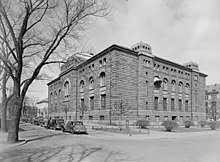Relocation of the Norwegian gold reserves during World War II
The outsourcing of the Norwegian gold reserves (norweg. Gulltransporten ) describes an episode of the Second World War in Scandinavia . The Norwegian government succeeded in moving the country's gold reserves from Oslo to Tromsø and from there to Great Britain in an operation lasting several weeks, thereby removing them from the German armed forces . The Norwegian government-in-exile was the only government-in-exile during World War II that was financially independent throughout the war. Accordingly, the manure transport became a Norwegian national myth after the war .
prehistory
One of the first measures that the German Reich took before and at the beginning of the Second World War to occupy countries was the confiscation of the respective national gold reserves , for example 201.2 tons in Belgium , 122.2 tons in the Netherlands and Luxembourg 4.3 tons. The German Reich was able to temporarily compensate for its lack of foreign currency through this gold holdings .
During the occupation of Norway - from April 9, 1940 as part of the Weser Exercise Company - an immediate confiscation of the gold reserves of the Norges Bank , the Norwegian central bank , was planned. However, the Norges Bank had expected this measure and had the country's gold reserves, a total of around 53 tons in bars and coins , made transportable in the weeks before. The gold bars were packed in 818 boxes of 40 kilograms each and in a further 685 boxes of 25 kilograms each, the gold coins in 39 barrels of 80 kilograms each.
Course of the operation

The occupation of Oslo by the Wehrmacht had been delayed by several hours due to the sinking of the heavy cruiser Blücher in the Oslofjord, so that the packaged gold stocks could still be brought to safety by employees of the Norges Bank. A total of 1,503 boxes and 39 barrels were loaded onto 26 civilian trucks and brought to Lillehammer .
Due to the advancement of the Wehrmacht northwards, the gold from Lillehammer had to be transported on April 19, 1940 with twelve railway wagons to Åndalsnes in western Norway, where British troops had landed in the meantime. From there the gold should be shipped to Great Britain.
Since the loading had to be canceled prematurely due to German air raids, the British cruiser HMS Galatea Åndalsnes left Åndalsnes on April 24 with only about eight tons of gold. The gold that remained in Norway was loaded onto trucks on April 25, 1940 and transported on to Molde .

On April 29th, 756 boxes with gold bars and all the barrels with coins were loaded onto the British cruiser HMS Glasgow , which - with the Norwegian government and King Haakon - went to Tromsø in northern Norway. The remaining gold stocks were first brought to the island of Frøya on several fishing trawlers and from there transported to Tromsø by larger ships.
About seven weeks after the occupation of Norway began, the remaining gold stocks left Tromsø on May 25, 1940 on the British cruiser HMS Enterprise . The Norwegian gold reserves were thus completely withdrawn from the Wehrmacht's access, with only about 300 coins of the total of 53 tons of gold being lost. The gold first came to Great Britain and was shipped to Canada in 1940 . The Norwegian government-in-exile covered its expenses during the war with the gold. A remainder of ten tons returned to Norway in 1987.
literature
- Pearson, Robert: Gold Run: The Rescue of Norway's Gold Bullion from the Nazis, 1940 . Casemate Books, 2015. ISBN 978-1-61200-286-6 (English)
- Turid Wammer: Gulltransporten 1940; Norges Bank, online on the Norges Bank website (Norwegian)
- Per Arnt Harnes: Gulltransporten - dramaet dag for dag , Romsdal sogelag, 2006 (Norwegian)
- Asbjørn Øksendal: Gulltransporten , Aschehoug, Oslo, 1974. ISBN 82-03-06336-5 (Norwegian)
- Ralf Banken: Precious metal shortage and large-scale robbery: The development of the German precious metal sector in the "Third Reich" 1933–1945 (Yearbook for Economic History. Supplements, Volume 13) - January 2009, ISBN 3-05-004380-6
Web links
- Aftenposten: Unik fotoskatt fra gulltransporten (2006) (Norwegian)
- The fate of the Norwegian gold reserves
Individual evidence
- ↑ Ralf Banken: Precious metal shortage and large-scale robbery: The development of the German precious metal sector in the "Third Reich" 1933-1945 (Yearbook for Economic History. Supplements, Volume 13) - January 2009, p. 844
- ↑ Werner Rings: Raubgold aus Deutschland , 1985, p. 34
- ^ Pearson, Robert: Gold Run: The Rescue of Norway's Gold Bullion from the Nazis, 1940 . Casemate Books 2015. ISBN 978-1-61200-286-6 , p. 16
- ^ Pearson, p. 54
- ^ Pearson, p. 57
- ^ Pearson, p. 58
- ↑ Pearson, pp. 83 ff
- ^ Pearson, p. 109
- ^ Pearson, p. 111
- ^ Pearson, p. 144
- ↑ NRK: Erling (94) risikerte livet for Norges gull i 1940 (Norwegian)
- ^ Pearson, p. 201
- ^ Pearson, p. 212
